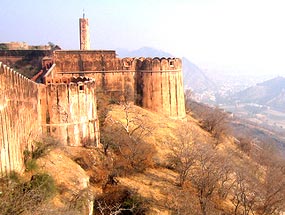Jaigarh fort is one of three magnificent forts
in the 'Pink City' of Jaipur. Know about the Jaigarh Fort of
Rajasthan, India.
Jaigarh Fort

Location: Jaipur, Rajasthan
Founded In: Between 15th and 18th Century
Jaigarh Fort, one of the most magnificent forts of India, is situated
in Jaipur, the 'Pink City' of Rajasthan. It is perched on top of a hill
and is situated in the outskirts of the city, at a distance of
approximately 15 km. Jaigarh fort is also known as the 'Fort of Victory'
and was constructed somewhere between 15th and 18th Century. It is still
in its original shape since not even once during its lifetime has it
fallen to enemy forces. One has to climb a steep road in order to reach
the main gate of the fort, known as Dungar Darwaza.
The road leading upto the fort provides a panoramic view of the
surroundings. The walls of Jaigarh fort are spread over three
kilometers. The fort used to serve as the center of artillery production
for the Rajputs. It is also home to the Jaivan Cannon, world's largest
canon on wheels. There is a 5 km long canal that used to bring in water
from the high hills, which was stored in the fort for the army men.
Jaigarh fort also served as the royal treasury of the Maharajas of
Jaipur for a number of years.
The legend has it that the Kings of Amber/Jaipur used the compartments
below the water tank to store the gold and jewelry. The various
structures inside the fort have been connected through numerous
passageways. Surrounding the Jaigarh Fort is a moat, which served as a
protection against enemy assaults. In the past, the fort was kept sealed
by the government for a period of seven years. This was done in the view
of the rumor that there is a huge treasure of gold buried in it. Many
searches and excavations were carried out, but they led to nothing.
Main Attractions of Jaigarh Fort
Jaivan Cannon
The huge Jaivan cannon has been placed on the top of a tower inside the
Jaigarh fort. It has an 8 m barrel, with a trajectory of about 20 km,
and weighs approximately 50 tons. It is said that the cannon is so
massive that it took four elephants to swivel it around on its axis.
However, what is more surprising is the fact that the cannon has not
been used till date. It was only test fired once by Jai Singh in 1720
and the cannon ball fell about 38km away. The impact of the test was the
formation of a lake on the spot and collapse of many houses in Jaipur.
Vijay Garh
Vijay Garh is the name given to the part of the fort that used to serve
as its armory. It boasts of a large compilation of swords and small
arms, including time bombs. Then, there is an interesting treasury lock
with five keys, big wine and oil jars and even a 1681 map of Amber. You
can also try your hands at the mini cannon kept here.
Jaigarh Cannon Foundry
The cannon foundry of Jaigarh dates back to the 16th century. One of
the few surviving medieval foundries in the world, Jaigarh cannon
foundry was built under Bhagwan Das. The collection of the foundry
includes a furnace, a lathe, tools and a number of cannons. After
Bhagwan's adopted son, Man Singh I, brought all information related to
gunpowder from Kabul, cannons began to be made in Jaigarh. There is a
point inside the foundry, known as Damdama, where ten cannons were kept
in a row, facing the Delhi Road.
Diya Burj
Diya Burj (the turret of lamps) is a seven-storied structure that
represents the highest point in the Jaigarh fort. The edifice offers an
amazing view of the Jaipur city. The water supply and storage system of
the fort is an amazing feat in itself. Sagar Talav, with octagonal
bastions and huge dams, is one of the biggest reservoirs of the fort.
Apart from that, there are a number of baolis (step wells) and temples
inside the complex. The most prominent temples are Shri Ram Hari Har
Temple and Kal Bhairava Temple.
Museums
The museums situated inside the Jaigarh Fort house an amazing
collection of paintings, photographs, puppets and ancient coins. Other
items displayed inside the museum include a balance for measuring
explosives, a 16th century coin container, etc.
Palace Complex
The entire palace complex of the Jaigarh Fort was built by various
kings, over a period of two centuries. The palace begins with the
Diwan-i-Aam (Hall of Public Audience). Then, we come across the Khilbat
Niwas (Commanders' Meeting Hall) and an open pillared hall, Subhat
Niwas. The luxury suites, namely Aram Mandir (Rest House) and Vilas
Mandir (Pleasure House), are definitely worth visiting. The pavilions
surrounding the courtyard have a labyrinth of passages and offer
excellent views of Amber Fort.
Lakshmi Vilas Palace
Lakshmi Vilas Palace is one of the most beautiful palaces inside the
Jaigarh Fort. The palace stands adorned with exquisite blue frescoes.
One can also see the remnants of an old Mughal garden. There is also a
little 'theater' hall, where dance, music recitals and puppet shows used
to be held for the entertainment of the royals.


